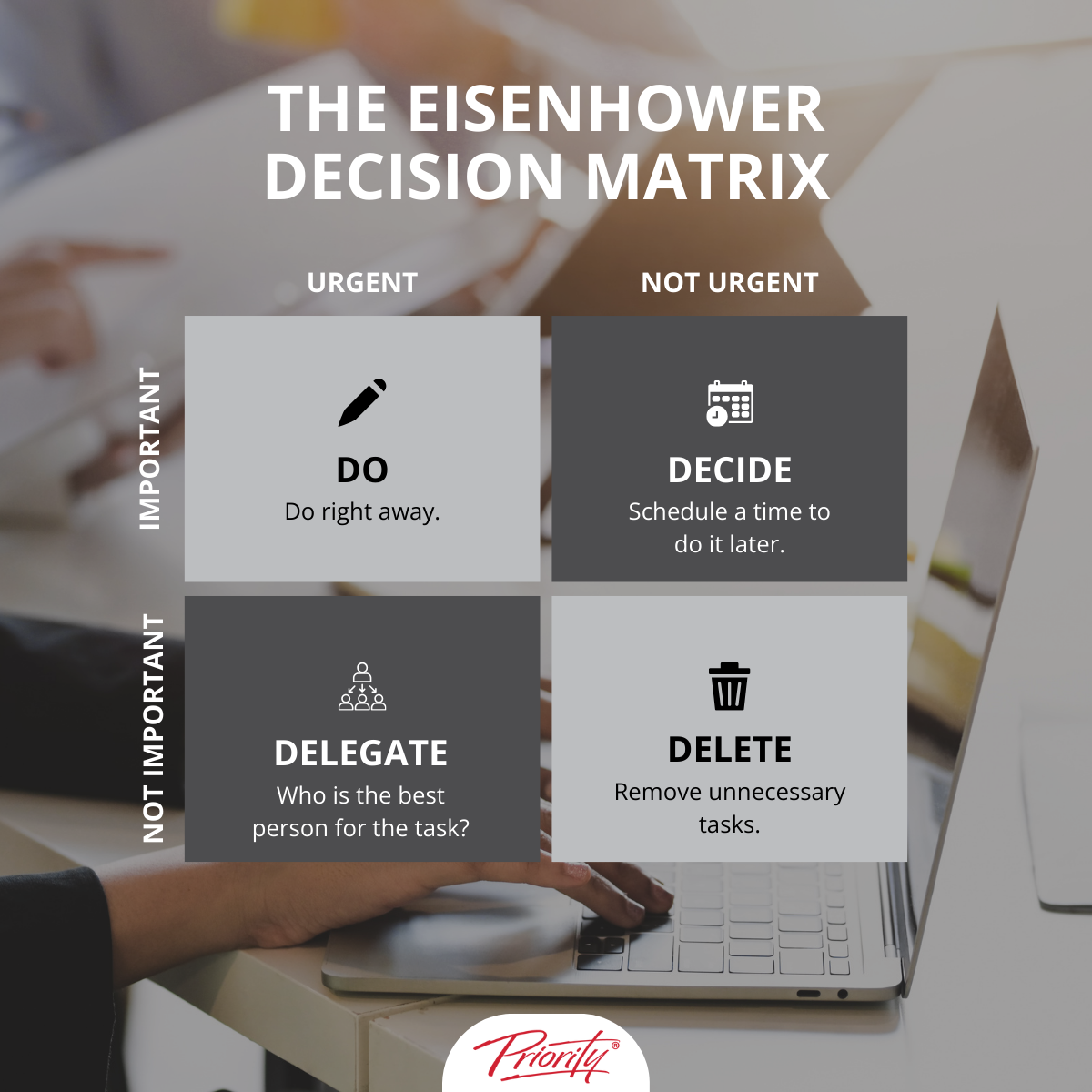There’s nothing like a to-do list to help you stay on task and feel productive. Having a daily, weekly, or monthly plan adds structure to our day and helps ease the anxiety of life’s chaos. Plus, we receive a nice hit of dopamine when tasks are ticked as complete.
But when the list looks longer than hours in the day, it’s nearly impossible to feel that rush.
An overflowing to-do list can lead to feelings of guilt, exhaustion, and burnout due to not being able to achieve an unrealistic number of goals set for the day. A long list of tasks has a negative impact on energy levels, mental health, productivity and efficiency.
The Eisenhower Matrix is a method for task prioritisation to help you manage your ever-growing to-do list and get on track for a productive day.
Importance of Prioritising Tasks
Whether it is in your personal or professional life, everyone can improve with new strategies to manage various projects, no matter how full your calendar and schedules seem. Even an experienced manager or team leader can improve their performance with better time management.
 Time management is the practice of organising specific activities and allocating the required amount of time to complete them. This can include chores, work deliverables, personal development, goals, planning and even distractions.
Time management is the practice of organising specific activities and allocating the required amount of time to complete them. This can include chores, work deliverables, personal development, goals, planning and even distractions.
Productivity and efficiency are intertwined with one’s mental health and energy management. Busy work may feel productive, but over time, the impact on your body and mind will take its toll. Therefore, finding methods to get better at prioritising tasks will improve your efficiency and sense of control over all aspects of your life.
How the Eisenhower Matrix Can Help
The Eisenhower Matrix, named after United States President Dwight D. Eisenhower (1890-1969), is sometimes called the Urgent-Important Matrix.
Eisenhower was a US Army general during World War II, the Supreme Allied Commander in Europe, and then the 34th President of the United States from 1953 to 1961. It’s no surprise Eisenhower needed a solid process for task prioritisation, as his workload ranged from supervising the Allied invasions of North Africa, Sicily, France, and Germany to serving as the president of Columbia University, leading NATO as its first Supreme Allied Commander, containing the spread of communism, and overseeing major domestic initiatives while in the White House.
The matrix is based on the premise that: “I have two kinds of problems, the urgent and the important. The urgent are not important, and the important are never urgent”. Although never directly recorded as a quote from Eisenhower himself, it encapsulates his approach to prioritisation.
The framework was popularised as a task management tool after its inclusion in Stephen Covey’s book The 7 Habits of Highly Effective People. It’s best used on paper or a digital platform like OneNote to get a clear overview of your task list, allowing you to consider your priorities clearly and visualise what’s ahead.
Understanding the Quadrants
The Eisenhower Matrix is a 2×2 grid and sorts tasks based on two key characteristics:
- How important the task is to the project or organisation’s success
- The urgency and deadlines of each task
The four boxes (or quadrants) in the Eisenhower template are:
- Urgent and important
- Not urgent, but important
- Urgent but not important
- Not urgent and not important
When categorising, it’s also helpful to consider which personnel can complete each task. For example, ‘important’ tasks likely cannot be delegated to someone who isn’t a key project stakeholder, as they require a high degree of quality and expertise. However, tasks that fall in the ‘not important’ quadrants can potentially be passed on to others to ease your workload.

Quadrant 1: Urgent and Important
The tasks of quadrant 1 are of the utmost priority and should be the first items on your to-do list. They are action items imperative to your overall project and must be carried out immediately. Avoid rescheduling them or delegating them to other personnel.
Activities in Quadrant 1 include:
- Addressing urgent client or customer requests
- Handling important legal or financial matters
- Responding to an IT crisis
- Submitting an important report or presentation before a final deadline
Managing Quadrant 2: Not Urgent but Important
Quadrant 2 is reserved for tasks that are critical for the overall project but do not have a set deadline. Though they do not need to be completed within a short timeframe, it’s a good idea to schedule allocated time for these tasks and prioritise them once quadrant 1 tasks are complete.
Activities in Quadrant 2 include:
- Long-term strategic planning and goal setting
- Creative thinking and recognising new opportunities
- Researching new project management tools, apps and templates
- Building relationships with new or existing clients
Delegating or Scheduling Quadrant 3: Urgent but Not Important
Quadrant 3 tasks should be delegated to external agents as they must be completed promptly but are not integral to the organisation’s progress. These tasks drain an organisation’s resources and should, therefore, be avoided where possible.
Activities in Quadrant 3 include:
- Responding to non-urgent questions, emails, or social media messages
- Attending non-essential meetings
- Doing small or optional tasks for a meeting, activities, or events
- Dealing with minor office distractions or interruptions

Eliminating or Minimising Quadrant 4: Not Urgent and Not Important
In the short term, these tasks yield minimal or no benefits and, therefore, lack a time frame. Delegate activities in Quadrant 4 to others in order to manage your time and look into stopping these tasks in the long term.
Activities in Quadrant 4 include:
- Attending meetings that aren’t relevant to your work
- Checking unimportant emails or email shuffling
- Looking at social media or other online distractions
- Dealing with trivial office matters
- Overanalysing minor decisions
Final Tips for Implementing the Eisenhower Matrix
Dedicate a set amount of time at the start of each day to organise your to-do list according to the Eisenhower Matrix. Decide which tasks must be done immediately, which can be delegated and which can be discarded. Try eliminating first; it will make prioritisation quicker.
Feel less overwhelmed by limiting the number of tasks allowed in each quadrant at any one time and use colour coordination to make high-priority tasks clear.
Once you have your newly organised list, quadrant 1 should be where you start your day. Tick off as many of these urgent tasks as possible in the first few hours of work. This leaves you time to focus on quadrant 2, the place for long-term strategic business development that will allow you to take your work to the next level.
Priority Management specialises in time management courses that save you 54 minutes every day and help you take control of your to-do list and productivity. Contact our friendly team today to learn more and decide which course best suits you and your goals.
